MO Better: SBS Brake Pad Review
Sinter the Dragon: Addressing the H-D Street 750's Weakest Link
We don’t always agree on everything at MO, but we do all agree that the new Harley-Davidson Street 750 could use a better front brake. Its revvable and lovable little 60-degree V-Twin engine is one of the best things Harley’s done in the 21st century and the rest of the bike’s not far behind for the money, but the response from its front brake let us down. In our recent Millennial Hep Cat Shootout, mean Tom Roderick said, “Where the Street 750 really fails in its performance package is with its lame front brake. Whether it’s the brake pad material or air in the line, the twin-piston single-caliper front disc brake is glaringly weak.”
2015 Harley-Davidson Street 750 Review – First Ride.
“As much as I was impressed with the engine, I was maybe equally negatively impressed with the brakes,” said Troy Siahaan. “Weak and wooden, they’re bad even for budget-bike standards.”
Always ready to defend the downtrodden when it’s not too much trouble and doesn’t cost me anything, I got hold of Johan Rauff Kristensen at Scandinavian Brake Systems to see what could be done. The next week, a box arrived packed with front pads for the Street 500/750, including SBS’s 924H.HF Ceramic pads and its 924H.LS Sinters. I knew I was on the right track when I saw myself on the packaging, riding a ZX-9R Kawasaki circa 1996.
The Street comes with ceramic pads of unknown origin. Ceramics, which are a mixture of ceramic and metal particles baked into the pad, are supposed to wear longer, be easier on rotors, make less noise and dust – most of which alleged benefits don’t much matter to motorcyclists, who just want to be able to stop hard when we need to. On the Street, which H-D markets as an entry-level bike, it makes semi-sense to provide a front brake you need all four fingers squeezing hard to lock up: H-D seems to sometimes go to great lengths to protect beginners from motorcycles that are able to start, stop or go around corners too fast.
Discuss this at our HD Street Forum.
Slipping SBS’s Ceramic H.HF pads into the Harley’s lone slide-type twin-piston front caliper resulted in slightly better power than the stock pads, but really barely enough to notice. Part of the problem may be that we motorcycle journalists are just spoiled; I’m used to being able to stand just about any new bike on its nose with two fingers on the brake lever. With two fingers on the Street’s lever and the stock pads, you’ll pull the lever back onto your other two fingers before you get hard, tire-chirping braking. With the SBS ceramics and two fingers, you can get the front tire chirping with a manly squeeze; with three, you can lock it up. Stopping from higher speeds, though, both the stock ceramic pads and the SBS ceramics fade before you come to a stop. Brakes turn energy into heat, and the ceramic pads can’t seem to make the transfer quickly enough on the little Harley.
Swapping the ceramics for the SBS 924 H.LS sinters (after bedding-in with a few miles of stop and go), provided much more positive results. Even without bleeding the system (sponginess was never the problem), the sinter pads somehow provide a firmer brake lever, and now, a good two-finger squeeze of the lever can get the front tire squealing. You can jump on the brake at 80 mph and still be decelerating hard during the last few feet before full stop; fade is greatly reduced compared to the ceramics. If the SBS sinter pads don’t add 20% more braking power and stop the bike at least 10 or 15% shorter from speeds above 60, I’ll eat 72% of my hat. On a sportbike, the Harley’s front brake would still be marginal; on a 505-pound cruiser, it’s now passable (especially while also using the rear, as God intended on cruisers).
The downside of sintered pads, with their all-metal content, is that they may be a little harder on brake discs. For most of us, possibly having to replace the occasional disc is a small price to pay for the increased margin of performance and safety (about $82 for H-D rotor Part Number 41500029 at many online outlets). A set of SBS 924H.LS Sinter pads for the Street will set you back about $29 at the same online retailers (MSRP for the ceramic pads is $33.95 per set, $39.95 for the sinters). An even smaller price to pay to significantly expand the little Street 750’s performance envelope.
More by John Burns



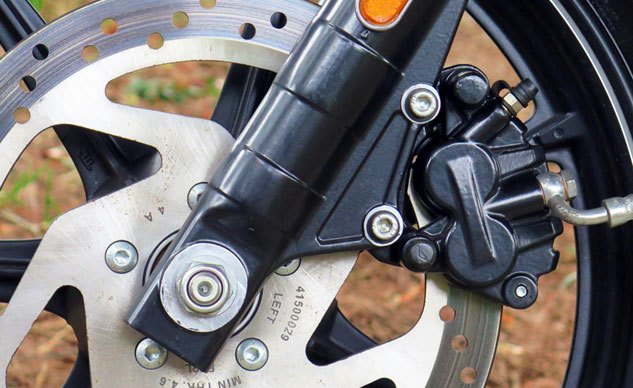
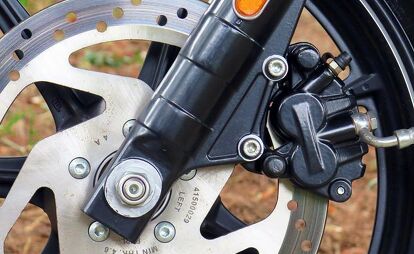













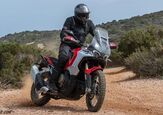
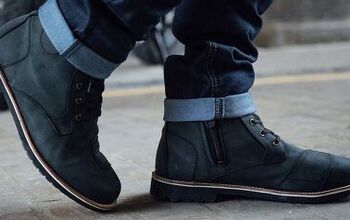


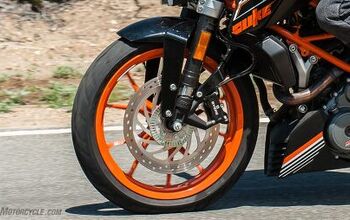














Comments
Join the conversation
I can't imagine why HD chooses to put only one rotor on this bike. I get why they do that on dual sport singles and dirt bikes, but there's really no excuse on a street bike, unless you're using Buell's massive rotor, and even that has always seemed marginal to me.
Alright... I agree that the brakes on this bike are bad enough to be called wooden. Now where do I find these pads? Please help.